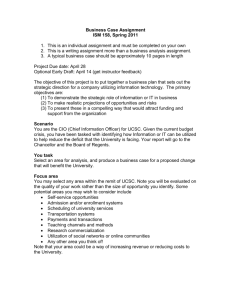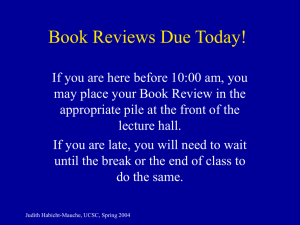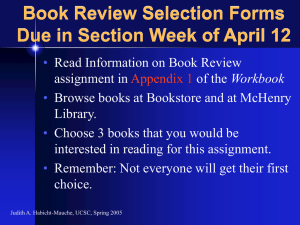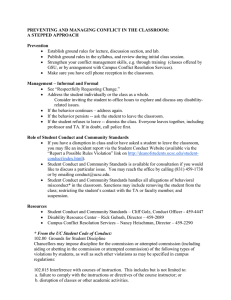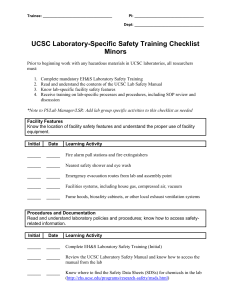ANTHROPOLOGY 3 INTRODUCTION TO ARCHAEOLOGY
advertisement
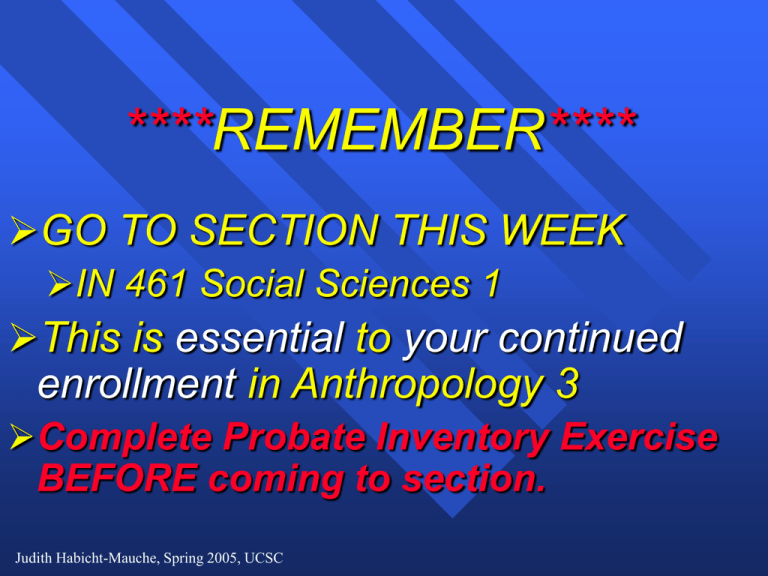
****REMEMBER**** GO TO SECTION THIS WEEK IN 461 Social Sciences 1 This is essential to your continued enrollment in Anthropology 3 Complete Probate Inventory Exercise BEFORE coming to section. Judith Habicht-Mauche, Spring 2005, UCSC Unit 1 Quiz on WebCT Available from 3:00 pm today until midnight on Friday. If you are enrolled in class you should be able to access quiz using your UC Cruzmail log-in name and password. If you enroll this week, you will need to register for this class on WebCT to access quiz. Don’t panic. If you are having trouble, ask for help. Try “Demonstration Quiz” before taking Unit 1 Quiz. Judith Habicht-Mauche, Spring 2005, UCSC Webcast Lectures and PPT Notes now on Web Site http://ic.ucsc.edu/~judith/anth3/ Judith Habicht-Mauche, Spring 2005, UCSC Archaeologists study material remains physical traces of human action in the world… Artifacts: humanly-touched things Features: human modifications in landscape (houses, hearths, pits, fields, roads,etc.) Ecofacts: objects of non-cultural origin (seeds, pollen, bones, shell, etc.) Is “Material Culture” Culture? Judith Habicht-Mauche, Spring 2005, UCSC Material remains meaningless outside of temporal and spatial context… Sites: loci of past human activities; three dimensional association of artifacts, features, and ecofacts. Cultural Landscapes: two dimensional association of sites and features. Vertical associations = relationships through time. Horizontal associations = relationships across space. Excavation and Survey: techniques for reconstructing vertical and horizontal associations between artifacts, ecofacts, features, and sites Judith Habicht-Mauche, Spring 2005, UCSC The World as Seen by Archaeologists: Material remains are by-products of learned, shared, cognitively structured behavior. Patterning in material record reflects cultural behavior in a systematic way. Task of archaeology is to reconstruct these patterns and explain their meaning--i.e. To tell stories about the past. Judith Habicht-Mauche, Spring 2005, UCSC Unit 1, Lecture 2 The Enlightenment Roots of Archaeology Archaeology’s peculiar way of “seeing and learning” about the past is recent and unique to the West By-product of radical intellectual and cultural developments in Europe during the 16th through 18th century-Renaissance and Enlightenment. Judith Habicht-Mauche, Spring 2005, UCSC Radical Idea No. 1 Humans are part of Nature and subject to its Laws and Conditions. Laws and Conditions discovered through Rational Inquiry--observation, experiment, analogy. Human Society legitimate subject of Rational Inquiry. Judith Habicht-Mauche, Spring 2005, UCSC Radical Idea No. 2 Material conditions of Human existence differ significantly across space and have changed through time. Interest in Classical Antiquity Industrial Revolution--notion of Progress European Colonial Encounters-- “primitive others” “living fossils” Judith Habicht-Mauche, Spring 2005, UCSC Radical Idea No. 3 Material remains or “antiquities” could be used to document material conditions in the past. Recognition of Pre-Roman past Nationalist antiquarian societies Recognition of Stone Tools as human artifacts Three Age System (C. Thomsen) **Artifacts more than mere curiosities; independent source of information about the past** Wm. Stuckley’s Stonehenge Recognition of Stone Tools as Human Artifacts By analogy with indigenous Americans’ tools: "I doubt not but you have often seen of those Arrowheads they ascribe to elfs or fairies, they are just the same as the chip'd flints the natives of New England head their arrows with at this day: and there are also several stone hachets found in this kingdom, not unlike those of the Americans.” William Lhwyd, Keeper of Ashmolean Museum, Oxford Stone tool found in France Emergence of a Discipline Several conceptual and methodological advancements in the 18-19th c. were critical to development of Archaeology as formal discipline. Made possible the systematic study of material remains of past human societies in their temporal and spatial contexts. Judith Habicht-Mauche, Spring 2005, UCSC Advances in Geology 18th century applied geology (canals, mines, etc.) Use of stratigraphy Layers in earth laid down successively in time Earth processes are regular, predictable William “Strata” Smith and “The Map that Changed the World” Advances in Paleontology (17th-19th Centuries) Fossils seen as remains of organisms Evidence for extinct species accepted Specific fossils assoc. w/ specific strata-- gradual, not catastrophic change through time. Realization of the Antiquity of the Human Species Association of Stone Tools w/ Extinct Fauna Discovery of pre-modern human fossils (Neanderthal, Germany) Thomas Huxley-“The Missing Link” Whole of Human history can not be accounted for by Biblical time scale-The Idea of “Prehistory”. Stratigraphic section from Abbeville, France Judith Habicht-Mauche, Spring 2005, UCSC Hoxne, Suffolk, England Excavated by John Frere, 1790 "The situation in which these weapons were found may tempt us to refer them to a very remote period indeed; even beyond Judith Habicht-Mauche, 2005, UCSC that of the Spring present world..." Sommes Gravels, Near Abbeville France Excavated by Jacques Boucher des Perthes, French Customs Inspector “antediluvian axes...” Judith Habicht-Mauche, Spring 2005, UCSC A Test of Human Antiquity: British Royal Society (1859) Creates Commission of Experts* Check B de P’s French evidence Dig a site with undisturbed stratigraphy *antiquarians & geologists, including Charles Lyell Judith Habicht-Mauche, Spring 2005, UCSC Test of Human Antiquity at Abbeville 1859 Boucher des Perthes’ claims verified stratigraphically by British Royal Society knives hatchets of flint Judith Habicht-Mauche, Spring 2005, UCSC Brixham Cave, Windmill Hill, England Brixham Cave Chosen for excavation: stalagmite layer sealed underlying archaeological deposits Judith Habicht-Mauche, Spring 2005, UCSC Brixham Cave Test: Relevant Evidence & Their Meanings Stone artifacts = human handiwork Fossil bones = extinct Ice Age species = Ice Age date Stratigraphic order = time sequence Association in 1 stratum = contemporary A long span of human “pre-history” widely accepted by scholars Judith Habicht-Mauche, Spring 2005, UCSC Development of Systematic Techniques of Excavation, Classification, and Dating in Europe and N. America (1880-1920s) Less emphasis on spectacular discoveries and treasures of antiquity Careful systematic recordings of finds and their spatial relationships Used to determine temporal ordering and interpretation of human behavior through pattern and association. Judith Habicht-Mauche, Spring 2005, UCSC Development of Systematic Techniques: General Augustus Lane-Fox Pitt-Rivers-Cranborne Chase, England (1880-1890s) A.V. Kidder--Pecos Pueblo, New Mexico (1915-1929) **Archaeology is established as a unique way of seeing and learning about the past Judith Habicht-Mauche, Spring 2005, UCSC
